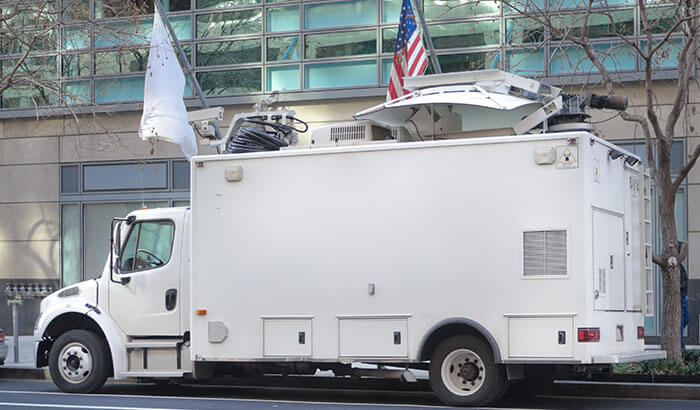What does the day of a truck driver really look like? Today we’re diving into what a typical day looks like behind the wheel.
You’ve probably heard some ads on the radio or seen an advertisement in your local newspaper with fleet members smiling widely, giving a thumbs up or their hands placed on their hips, looking happy and content. But what do truck drivers experience on a daily basis? What do their days consist of?
It may sound cliche, but it really is true for those living life on the road that every day is different. There are fun, satisfying, challenging, interesting, frustrating moments — sometimes all within the same day! As a truck driver, you could spend one day enjoying the view along a mountainous highway, and a few hours later, you could get stuck in heavy traffic in a city.
So what does a typical day look like? Continue reading to find out.
A Typical Morning for a Truck Driver
Here’s what a typical morning might look like:
Early to Rise — Many drivers opt for an early start, many waking before 6:00 AM. Depending on your situation, you may wake up right in your truck in some bedding and a pillow you brought from home.
Eat Breakfast — Find something to eat. Some days it will be something you bring along to ear, and other days you’ll stop by a local restaurant.
Shower and Get Ready — You may decide to take a shower before you head out for the day, or perhaps you might choose to take one a bit later in the day when you stop at a truck stop to fuel up or at one of your operating centers.
Pre-Trip Inspection — After breakfast and getting ready for the day, you’ll conduct a pre-trip inspection to ensure the truck and its major systems are all in check.
Hit the Road — Once you know everything is in good working condition, you are safe to hit the road.
A Truck Driver’s Typical Afternoon
While most mornings start out the same for drivers as many of them like to stick to a routine, the rest of the day is usually different from one day to the next. Here are some ways it could go:
Drop-and-Hook — You may need to drop off your trailer and pick up a new, empty one to bring to another shipper.
Live Load or Unload — You may wait around while a trailer is loaded or unloaded at a receiving dock.
Take a Break — In the middle of the workday, you’ll need to take a 30-minute break mandated by the Department of Transportation. This is a great time to take a walk, stretch, grab some food, catch up with loved ones, or watch some in-cab satellite TV. A quick break will keep you fresh and get you ready for the second part of your route for the day.
A Typical Evening for a Truck Driver
If a truck driver knows where their day will end, many of them will plan a place to spend the night in advance. It is often one of many truck stops along their route or in a safe, well-lit rest stop.
Many of these stops have been updated and provide amenities like laundry facilities, showers, and plenty of food options. The more you drive, the more familiar you’ll become with various routes, and you’ll get really good at finding a go-to destination that you like. However, regardless of where you end up, this is what a typical evening looks like:
Find Parking — You may want to get parked early, no later than 7 PM, so you’re sure to find a spot you like.
Post-Trip Inspection — Conduct a post-trip inspection to ensure your truck and trailer is in good shape after a day on the road.
Complete Any Paperwork — Finish any remaining paperwork or work-related tasks.
Eat Some Dinner — By the end of the day, most drivers are more than ready to eat. Whether you bring your own food to be prepared on board or find a local place to dine, making sure you’re taking care of yourself is essential.
Enjoy a Little Free Time — Speaking of taking care of yourself, it is crucial to find a good work-life balance, especially for drivers living a chunk of their lives on the road. Find something that you love to do that you can do during your breaks or evenings on your long hauls. Here are some ways you can spend your free time:
- Reading a book
- Listening to a podcast at a nearby park
- Hiking on local trails
- Touring local must-see spots
- Watching in-cab satellite TV
Every Truck Driver Needs EpicVue
Life on the road as a truck driver might seem a bit chaotic, but at the end of your day or during a mandatory break, the best way to wind down is with EpicVue.
EpicVue specializes in outfitting vehicles with premium in-cab satellite televisions so drivers can kick back and catch up on their favorite TV shows, latest news reports, or sports events while away. Enjoy the comforts of home with our satellite TV that lets you stay connected, regardless of where you are on the road.
It’s easy to feel isolated, secluded, and lonely during a long haul, but watching TV while you’re away can help cancel out those overwhelming feelings. It’s the perfect way for truck drivers to unwind during their mandatory rest and recovery time in the comfort of their own truck.
Equipping your vehicles with EpicVue creates loyalty, appreciation, and commitment between drivers and their fleets. Happy, healthy employees are much more likely to stay with their fleet, which greatly reduces the expensive cycle of recruitment and retention. The benefits you and your team will see make EpicVue a fantastic investment! Aren’t a part of a fleet? Even if you own your own rig, EpicVue is the perfect addition to your truck!
With many premium channels, truck drivers are sure to find something to watch, regardless of their preferences. Contact us to learn more!



